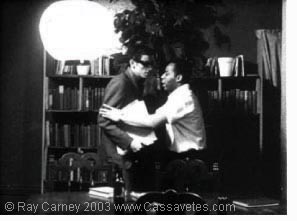|
 "Stylistic
unity drains the humanity out of a text" "Stylistic
unity drains the humanity out of a text"
If the film is primarily
the creation of the director or the writer, then you have only
a
single viewpoint upon the theme. It is the creation of only one
imagination. But if the film is created out of the actors, then
the work has as many facets as there are actors; the action is
seen
in the round – the communal creation of several imaginations. Consider
the movie as artwork on canvas. You begin with ideas, something
of your own, somebody else adds something different and it changes
a bit. Stylistic unity drains the humanity out of a text.
There was a doubleness
in Cassavetes' method, however. Even as he reined the actors in
and had very strong ideas about what he wanted from them, he insisted
that they should bring a lot of themselves and their own ideas
to
the role. In fact, in Cassavetes' view, the difference between Shadows
and most other films resided almost entirely in the centrality
of
the actor's contribution to the creative process. The goal of most
directors, particularly virtuosic ones like Sternberg, Welles,
Hitchcock
and Kubrick, is to impose their vision on their works, so that
each
shot, scene and interaction bears their imprint. Cassavetes went
in the opposite direction, depending heavily on his performers'
input. If the first kind of filmmaking can be called "concentrative" – so
that the points of view of the various figures within the
work ultimately cumulate in a single, overarching way of seeing
and feeling, Cassavetes' might be called
"dispersive," because
it imagines the work to be the product of as many different personal
voices, styles and moods as possible. The point was not to unify
the work around a singular point of view, but to diversify it by
allowing in as many different points of view as possible.
Loose Lips Sink
Ships
Actors developed their
characters separately, and, if necessary, kept secrets from each
other about what their characters felt, wanted, or knew. The danger
was that if actors discussed their roles with each other, they might
unconsciously incorporate each other's views into their own, homogenise
the work, and play their relationship falsely. It represented another
difference of opinion with Strasberg:
I differ from the
working method advocated by Stanislavski and followed by the Actors
Studio, which involves group discussion of the characters. For
me each role must be an individual's conception as well as an
individual creation. If each role is the result of communal study
by director and ensemble, everything will dovetail; it will all
be nice and neat and smooth; but the conflict of the characters
won't be truthful. The actors don't discuss their interpretations
sitting around in a group. The general theme of the work, of course,
must be studied by the whole group, so that we share the same
overall conception; but each actor must come at his own interpretation
of his role, without the sort of group study and mutual criticism
which one associates with Method work.
Shadows, Published
by the British Film Institute (London, England)
Distributed in America by
the University
of California Press at Berkeley
ISBN: 0-85170-835-8
88 pages; thirty illustrations
This
page only contains excerpts and selected passages from Ray Carney's
writing about Shadows. To obtain the complete text as well
as the complete texts of many pieces about Cassavetes that are not
included on the web site, click
here.
|









